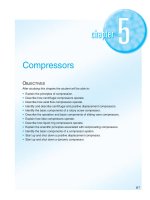2023 1 embedded systems chapter 6
Bạn đang xem bản rút gọn của tài liệu. Xem và tải ngay bản đầy đủ của tài liệu tại đây (1.18 MB, 20 trang )
<span class="text_page_counter">Trang 1</span><div class="page_container" data-page="1">
<b>HỆ THỐNG NHÚNG</b>
Dr. Thanh Nguyen
<small>Email: : Room 606 - Building A4</small>
Chapter 6: Embedded System Design Process
</div><span class="text_page_counter">Trang 2</span><div class="page_container" data-page="2"><b>Content </b>
▪ Design methodologies
▪ Embedded system design process ▪ Discuss the recent trends.
▪ Major application areas.
</div><span class="text_page_counter">Trang 3</span><div class="page_container" data-page="3"><b>Design MethodologiesDesign Methodologies</b>
▪ It is a procedure for designing a system.
▪ Keep a scorecard on a design to ensure that we have done everything
we need to do
▪ Develop computer-aided design tools
▪ Makes it much easier for members of a design team to communicate
</div><span class="text_page_counter">Trang 4</span><div class="page_container" data-page="4"><b>Design Methodologies</b>
<b>Embedded System Design Process</b>
▪ Top-down design:
▪ start from most abstract description. ▪ work to most detailed.
</div><span class="text_page_counter">Trang 5</span><div class="page_container" data-page="5">At each Step in the design, ▪ Analyze, Refine, & Verify
</div><span class="text_page_counter">Trang 6</span><div class="page_container" data-page="6"><b>Design MethodologiesDesign Process</b>
<small>Determine the requirements </small>
<small>Design the system </small>
<small>architecture</small> <sup>Select the OS</sup> <small>Verify the software</small>
<small>On the host system</small>
<small>Verify the softwareOn the target </small>
<small>system</small>
</div><span class="text_page_counter">Trang 7</span><div class="page_container" data-page="7"><b>Design MethodologiesRequirements</b>
▪ Before we design a system, we must know
what product we are designing.
▪ Plain language description of <b>what the user wants and expects to get</b>.
▪ May be developed in several ways: ✓ Discuss <b>directly to customers</b>.
✓ Discuss to <b>marketing representatives</b>.
✓ Provide <b>prototypes</b> to users for comment.
</div><span class="text_page_counter">Trang 8</span><div class="page_container" data-page="8">✓ Performance - time required ✓ size, weight, etc.
✓ power consumption ✓ reliability
✓ etc..
</div><span class="text_page_counter">Trang 9</span><div class="page_container" data-page="9"><b>Design MethodologiesSpecification</b>
▪ It serves as the contract between the customer and the architects. As such, the specification must be carefully written so that it accurately reflects the
<b>customer’s requirements</b> and does so in a way that can be clearly followed during design.
▪ The specification should be <b>understandable</b> enough so that someone can verify that it meets system requirements and overall expectations of the customer.
</div><span class="text_page_counter">Trang 10</span><div class="page_container" data-page="10"><b>Design MethodologiesArchitecture design</b>
▪ Architecture is the plan for the overall structure of the system that will be used later to design the components that make up the architecture.
▪ Architecture design must give an idea about
✓ What major components need for satisfying the specification? ✓ What hardware components need? like CPUs, peripherals, etc. ✓ What Software components need?
✓ Must take into account functional and non-functional specifications..
</div><span class="text_page_counter">Trang 11</span><div class="page_container" data-page="11"><b>Designing hardware and software</b>
▪ Some components are ready-made, some can be modified from existing designs, others must be designed from scratch (that is new design).
</div><span class="text_page_counter">Trang 12</span><div class="page_container" data-page="12"><b>System Integration</b>
<b>▪ System integration is Putting together </b>the components. ✓ Many <b>bugs</b> appear only at this stage.
<b>▪ Bugs</b> are typically found during system integration, and good planning can help us find the bugs quickly.
▪ System integration is difficult because it usually uncovers problems. It is often hard to observe in the system, <b>to determine exactly what is wrong </b>- the
debugging facilities for embedded systems are usually much more limited than what you.
▪ Inserting appropriate debugging facilities during design can help ease system
</div><span class="text_page_counter">Trang 14</span><div class="page_container" data-page="14">✓ Water Identifier Sensors ✓ Acceleration Sensor - 3 Axis ✓ Glass braking sensor
Modules & industrial standard sensors
</div><span class="text_page_counter">Trang 15</span><div class="page_container" data-page="15">✓ Digital Pressure Sensor
✓ Digital Temperature Sensor ✓ Bump Sensor (Touch Sensor)
</div><span class="text_page_counter">Trang 16</span><div class="page_container" data-page="16"><b>Application Areas Consumer electronics</b>
</div><span class="text_page_counter">Trang 17</span><div class="page_container" data-page="17"><b>Application Areas Industrial Automation</b>
</div><span class="text_page_counter">Trang 18</span><div class="page_container" data-page="18"><b>Application Areas Biomedical Systems</b>
</div><span class="text_page_counter">Trang 19</span><div class="page_container" data-page="19"><b>Application Areas </b>
<b>Telecommunication Systems</b>
</div><span class="text_page_counter">Trang 20</span><div class="page_container" data-page="20"><b>Summary </b>
▪ Design methodologies
▪ Embedded system design process ▪ Discuss the recent trends.
▪ Major application areas.
</div>








